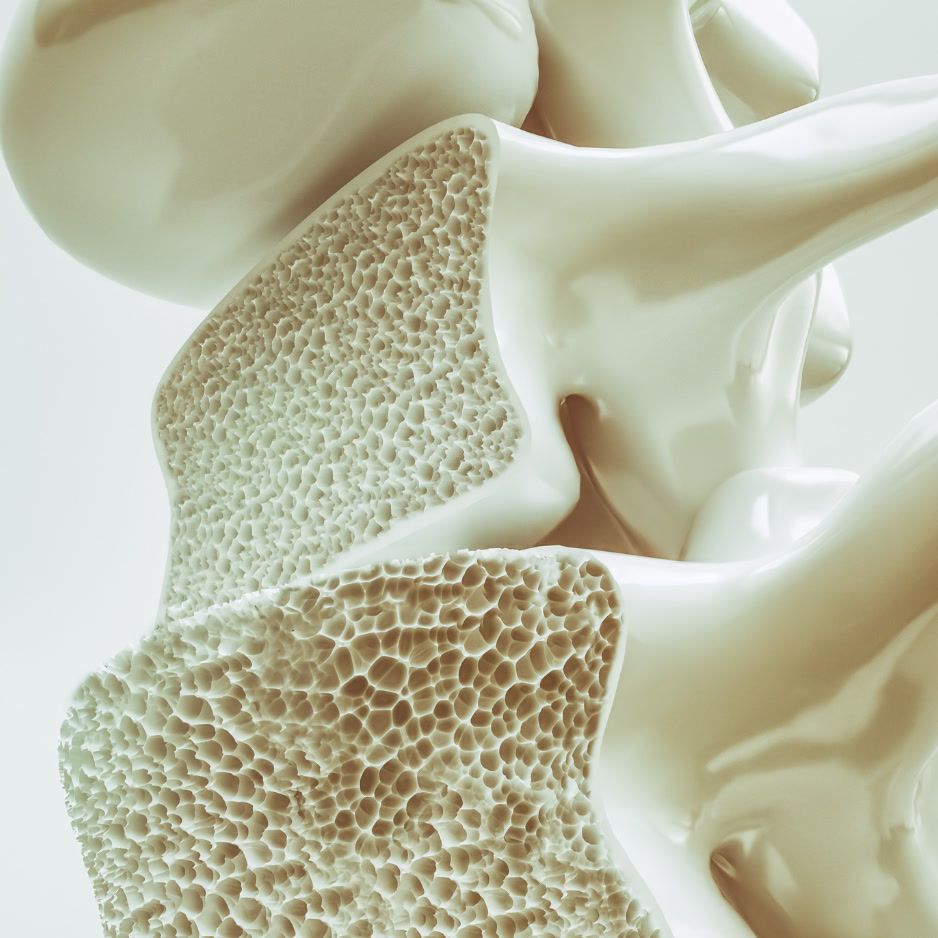The Ultimate HYROX Training Guide

The Ultimate HYROX Training Guide: Free 12-Week, 8-Week, and Advanced Programs
So you’ve signed up (or are this close to signing up) for a HYROX race: eight rounds of a 1 km run immediately followed by a functional workout station—think ski erg, sled push, burpee broad jumps, and the grand-finale wall balls. It’s equal parts endurance grind and strength showdown, and generic 5 k plans or random WODs won’t cut it.
Below you’ll find three tiered, structured programs rooted in established training principles—plus the recovery, nutrition, and body-composition insights that separate finish-line fist bumps from “DNF.” Whether you’re a first-timer chasing a sub-two-hour goal or a CrossFit coach eyeing a 70-minute podium, we’ve got your roadmap.
Quick refresher: HYROX’s standardized format—run 1 km + station × 8—means results are globally comparable, age-group ranked, and perfect for prepping with data-driven checkpoints HYROX About.
Table of Contents
- What Makes HYROX Unique?
- Picking Your Program
- 12-Week Beginner Plan (3–4 days/week)
- 8-Week Time-Crunched Plan (4 days/week)
- 12-Week Advanced Plan (5–6 days/week)
- Key Training Elements Explained
- Mobility & Recovery Essentials
- Race-Day Fueling & Body Composition
- Tracking Progress with BodySpec DEXA
- Free vs Paid Plans: Side-by-Side
- HYROX FAQ
1. What Makes HYROX Unique?
HYROX bridges the gap between road racing and functional fitness. Unlike obstacle-course races, every rep is repeatable indoors, so your finish time comes down to three levers:
- Running economy – 8 km total, often on carpet or rubber flooring.
- Strength-power capacity – a 350-lb/159-kg sled push in the Pro division demands legit lower-body force – see the Men’s Health sled guide.
- Transition efficiency – the clock doesn’t stop between the run and the station; learning to drop heart rate on the move is crucial.
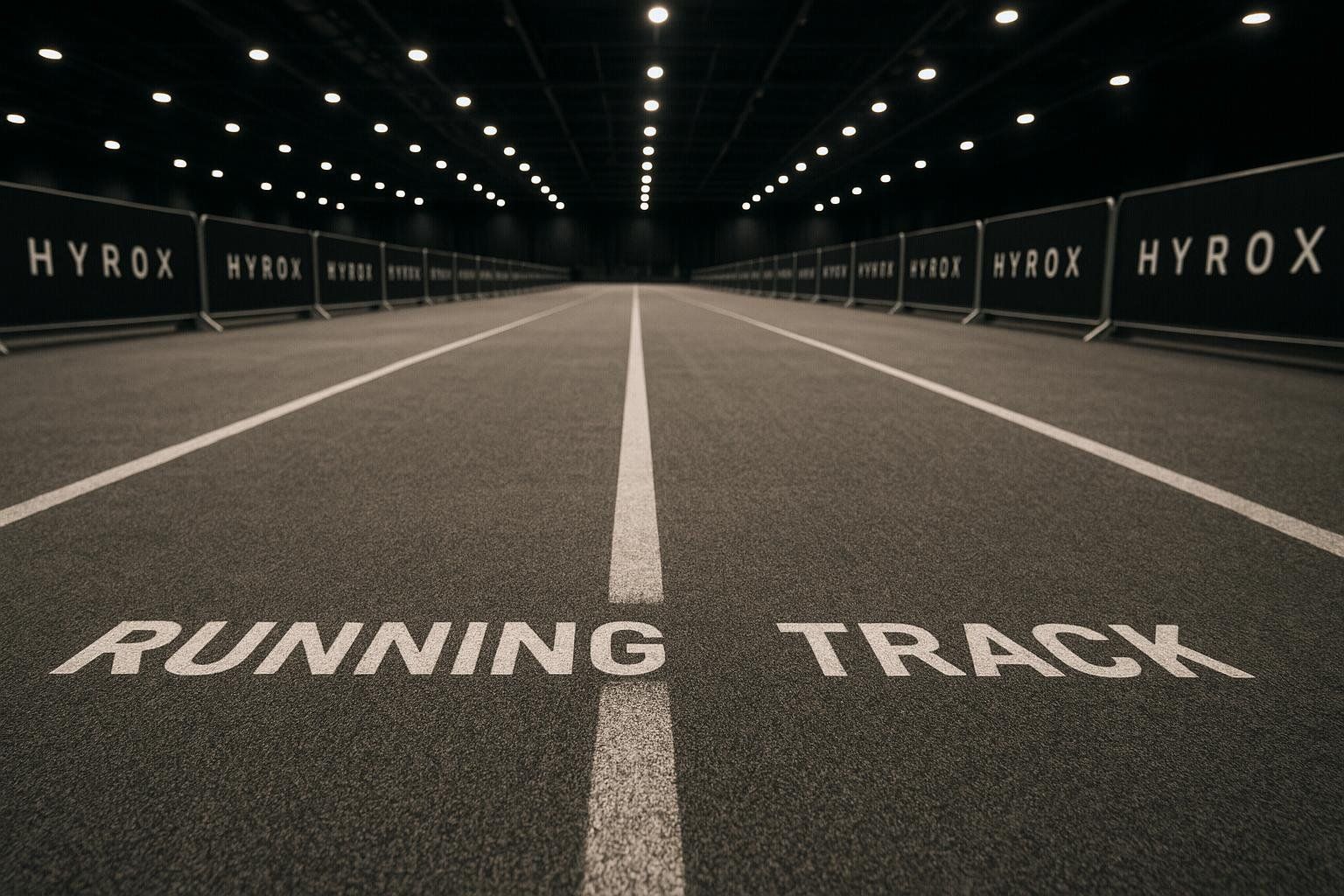
Because the format is fixed, smart athletes periodize training just like marathoners—building base, adding intensity, then sharpening with race simulations.
2. Picking Your Program
Use the table below to choose:
| You Are… | Weekly Available Training Hours | Recent 5 k Time | Choose This Plan |
|---|---|---|---|
| HYROX Newbie | 4–6 hrs | 30–35 min | 12-Week Beginner |
| Busy Professional | 3–5 hrs | 25–30 min | 8-Week Time-Crunched |
| Competitive/CF Athlete | 6–10 hrs | sub-22 min | 12-Week Advanced |
All three share the same training pillars; intensity and volume scale.
3. 12-Week Beginner Plan
Frequency: 3–4 sessions/week (2 hybrid, 1 run, optional mobility)
Weeks 1–4 – Base & Movement Quality
| Day | Session | Notes |
|---|---|---|
| Mon | HYROX Combo A: 4 × (500 m run @ conversational + 10 burpee broad jumps) | HR < 80 % max |
| Wed | Strength Circuit: Goblet squats, dumbbell lunges, ski-erg technique | Quality over load |
| Sat | Easy run 5 km | Steady zone-2 |
| Sun | 20-min yoga/foam roll | optional |
Weeks 5–8 – Strength Endurance
| Day | Session | Notes |
|---|---|---|
| Mon | Sled Push EMOM: 8 × 12 m push @ race weight | Walk-back recovery |
| Tue | Run Intervals: 3 × 1 km @ 10 k pace, 2-min walk | |
| Thu | Station Technique: 4 rounds — 12 cal ski-erg + 15 kettlebell swings | Grip focus |
| Sat | Tempo Run 6 km (RPE 6) + 4 strides |
Weeks 9–11 – Specificity & Simulations
| Day | Session | Notes |
|---|---|---|
| Mon | Run + Station: 3 × (1 km run + 20 wall balls) | 70 % race pace |
| Wed | Pull & Carry: Farmer’s carry 100 m + sled pull 15 m × 4 | |
| Fri | Full Simulation (Week 11 only): 1 km run + station × 8 @ 80 % load | Time every split |
| Sun | Mobility & Active Recovery 30 min |
Week 12 – Taper & Race
| Day | Session | Notes |
|---|---|---|
| Tue | Easy run 4 km + 4 × 20-sec strides | |
| Thu | Light Station Primer: 2 rounds 10 cal ski-erg + 10 wall balls | Stay fresh |
| Sat | Race Day! | Go time |
4. 8-Week Time-Crunched Plan

Frequency: 4 sessions/week (~60 min each)
| Week | Mon | Wed | Fri | Sat |
|---|---|---|---|---|
| 1 | Zone-2 run 30 min + 3 × 15 cal ski-erg | Lower-body strength: 4 × 8 goblet squats, 4 × 10 walking lunges | Sled technique: 6 × 10 m push (light) + 6 × 10 m pull | Easy run 5 km + mobility 10 min |
| 2 | Zone-2 run 35 min + 4 × 15 cal ski-erg | Lower-body strength: 4 × 10 goblet squats (heavier), 4 × 12 walking lunges | Sled technique: 6 × 12 m push (moderate) + 6 × 12 m pull | Easy run 6 km + mobility 15 min |
| 3 | 5 × (400 m run + 10 burpee broad jumps) | Push/pull strength: 4 × 6 bench press, 4 × 8 bent-over row | Sled push 5 × 15 m @ race weight + 400 m run | Recovery bike 30 min |
| 4 | 4 × (400 m run + 8 burpee broad jumps) @ RPE 8 | Push/pull strength: 4 × 5 bench press (heavier), 4 × 6 bent-over row | Sled push 6 × 15 m @ race weight (shorter rest) | Easy run 6 km (zone-2) |
| 5 | 4 × (1 km run @ race pace + 25 wall balls) | Ski-erg sprints: 10 × 12 cal on :45 / off :45 | Deadlift 4 × 5 (moderate) + core circuit | Easy run 6 km |
| 6 | 5 × (1 km run slightly faster than race pace + 20 wall balls) | Ski-erg sprints: 10 × 15 cal on :45 / off :45 | Deadlift 4 × 5 (moderate-heavy) + core circuit | Recovery bike 40 min + mobility |
| 7 | Zone-2 run 20 min + running drills | Full simulation: 1 km run + station × 8 @ 80 % load | – | Technique & mobility 30 min |
| 8 | 20-min easy jog + 4 strides (Tue) | Light station flow 1 round each @ 50 % load (Thu) | – | Race Day (Sat) |
5. 12-Week Advanced Plan
Frequency: 5–6 sessions/week
Block Overview
| Weeks | Primary Focus | Key Benchmarks |
|---|---|---|
| 1–2 | Aerobic base & movement quality | 30–40 km weekly run volume; technique sled drills |
| 3–4 | Muscular endurance & sled strength | Sled push to 10 % above race weight; long station EMOMs |
| 5–6 | Threshold & VO₂ max | Cruise intervals 6 × 1 km @ 10 k pace; HR-cap tests |
| 7–8 | Heavy strength overload | Sled push/pull 110–120 % race load; front squat 85 % 1RM |
| 9–10 | Double-day specificity | AM run + PM stations; goal < 5 % pace drop |
| 11 | Full race simulation | Complete full HYROX under comp rules |
| 12 | Taper & recovery | 50 % volume; daily mobility; sharpen with strides |
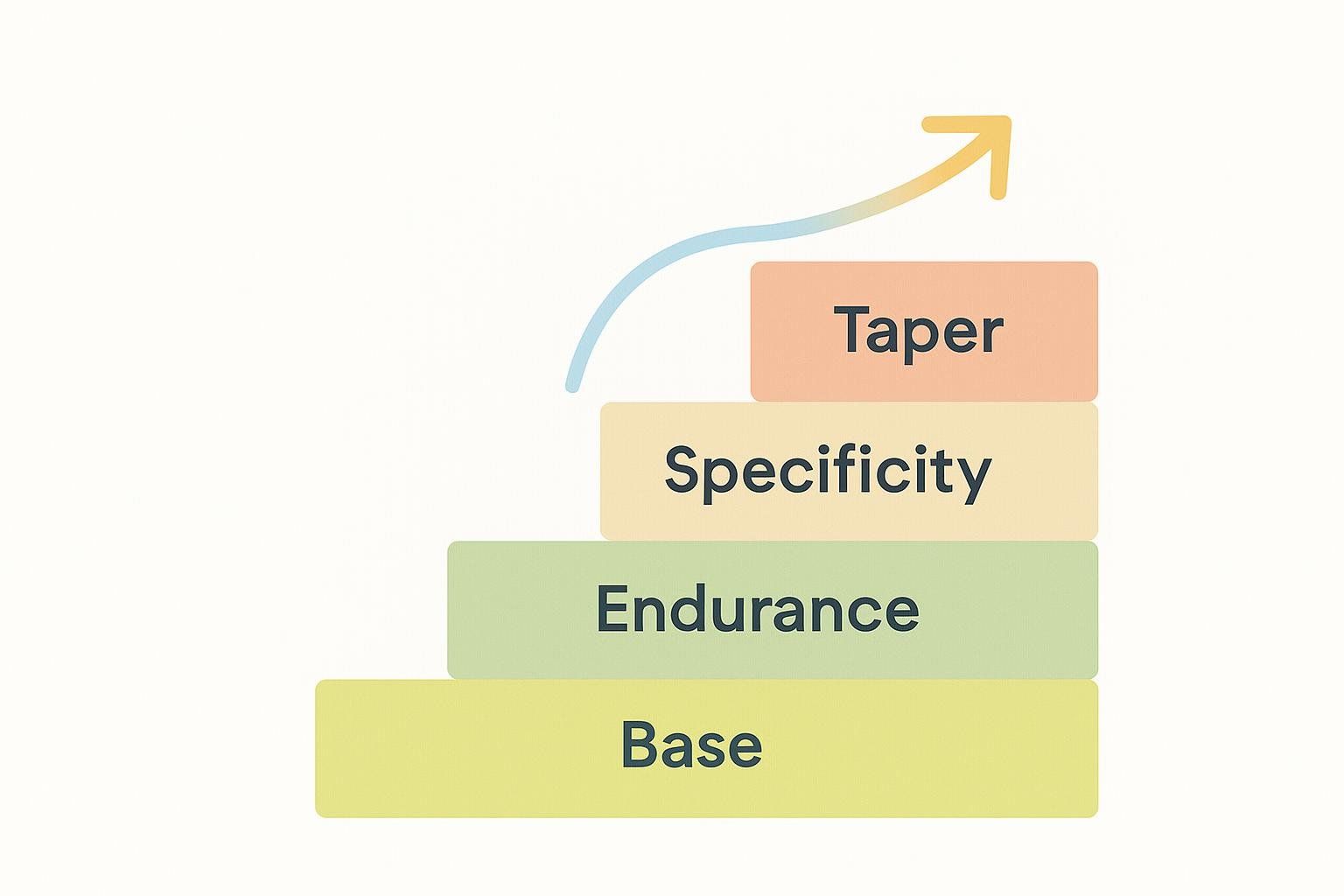
Sample Week – Week 9 (Specificity Phase)
| Day | AM Session | PM Session |
|---|---|---|
| Mon | 8 km steady run (zone-2) | Lower-body strength: 5 × 5 front squat @ 80 % 1RM + sled push technique |
| Tue | Intervals: 6 × 800 m @ 5 k pace, 90-sec rest | Mobility + core 20 min |
| Wed | Easy run 5 km | Station EMOM 30 min: rotate ski-erg 12 cal, burpee broad jumps 10, wall balls 15 |
| Thu | Active recovery swim 30 min | – |
| Fri | Race-Pace Simulation: 2 × (1 km run + sled push 12 m + sled pull 12 m + run 500 m) | Upper-body pull: 4 × 6 barbell row, 3 × max-rep pull-ups |
| Sat | Long run 12 km (RPE 6) | Stretch + percussion gun 15 min |
| Sun | Mobility & contrast shower | – |
6. Key Training Elements Explained
Understanding the core components of HYROX preparation helps you tailor workouts to your own strengths and weaknesses. Here’s a breakdown:
Running Volume
Aim for roughly 3 × your total event distance weekly (≈ 24 km) during peak, split into intervals and easy mileage.
Sled Push & Pull Strength
Front-loaded sled drags, heavy prowler pushes, and barbell front squats build leg drive. Progressive overload: + 10 lb each week until 10 % above race weight.
Erg Efficiency (Ski & Row)
Technique beats brute force: focus on long strokes at 30–32 spm, breathing every pull.
Wall-Ball Capacity
Accumulate 100–150 reps/week. EMOM sets and 50-rep unbroken tests help gauge readiness.
Transition Heart-Rate Drops
Practice 30-sec nasal-breathing walks between run and station to train parasympathetic shift.
(For deeper programming theory, see Periodization Training: Planning Your Workouts for Maximum Gains.)
7. Mobility & Recovery Essentials
Poor ankle dorsiflexion torpedoes sled pushes; tight T-spines wreck wall-ball accuracy. Spend 10 minutes post-workout on:
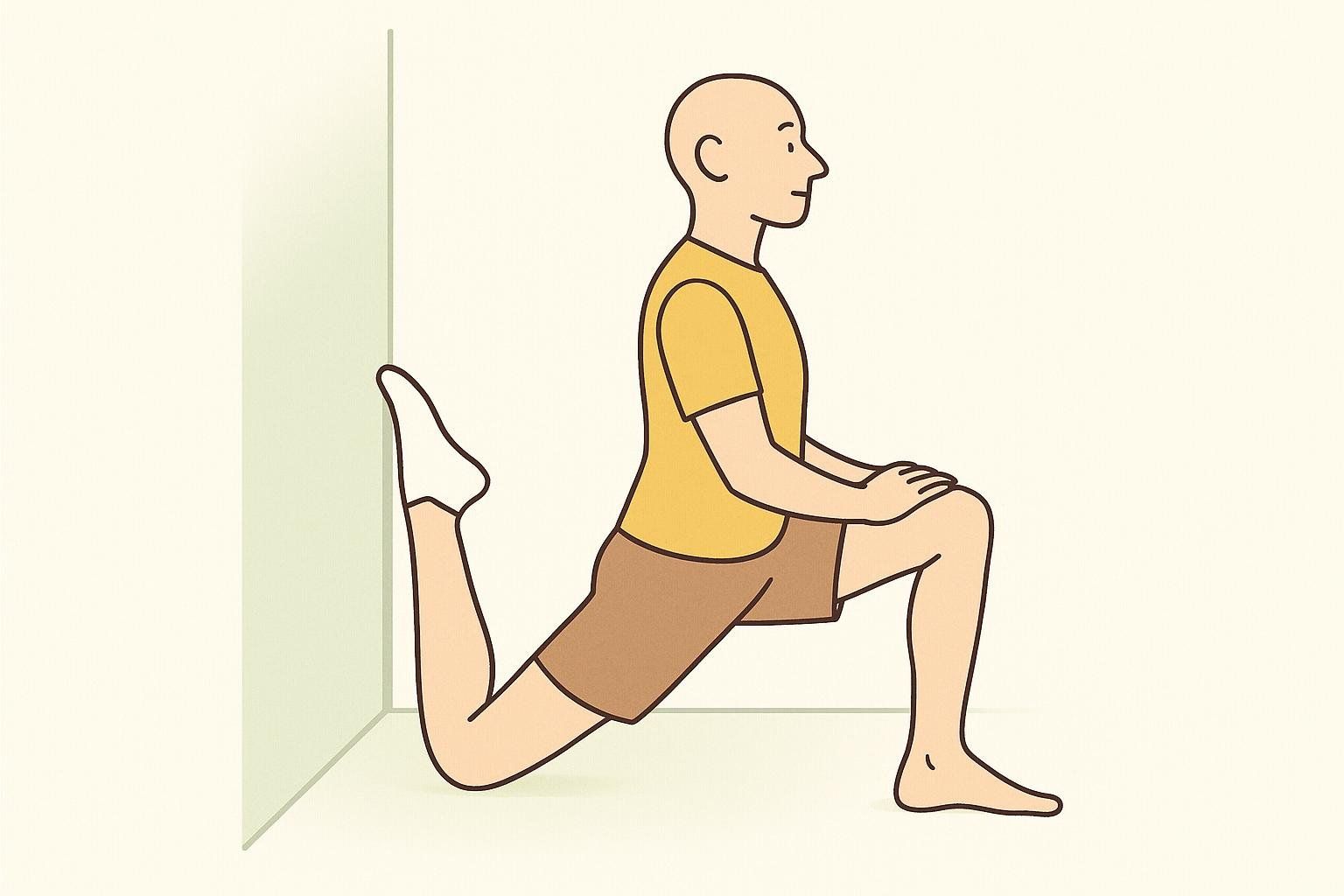
- Couch stretch – 60 sec per side
- Thoracic-spine openers – 2 × 30 sec
- Calf raises with eccentric lowers – 2 × 15 reps
Protect your investment with a weekly rest day—your body grows stronger between sessions, not during them. Read more in Workout Recovery: The Importance of Rest Days.
Need more ideas? Check Injury Prevention: Exercises and Tips to Stay Safe.
8. Race-Day Fueling & Body Composition
HYROX is estimated to burn roughly 700–1,000 kcal/hour. Enter the arena topped up on muscle glycogen:
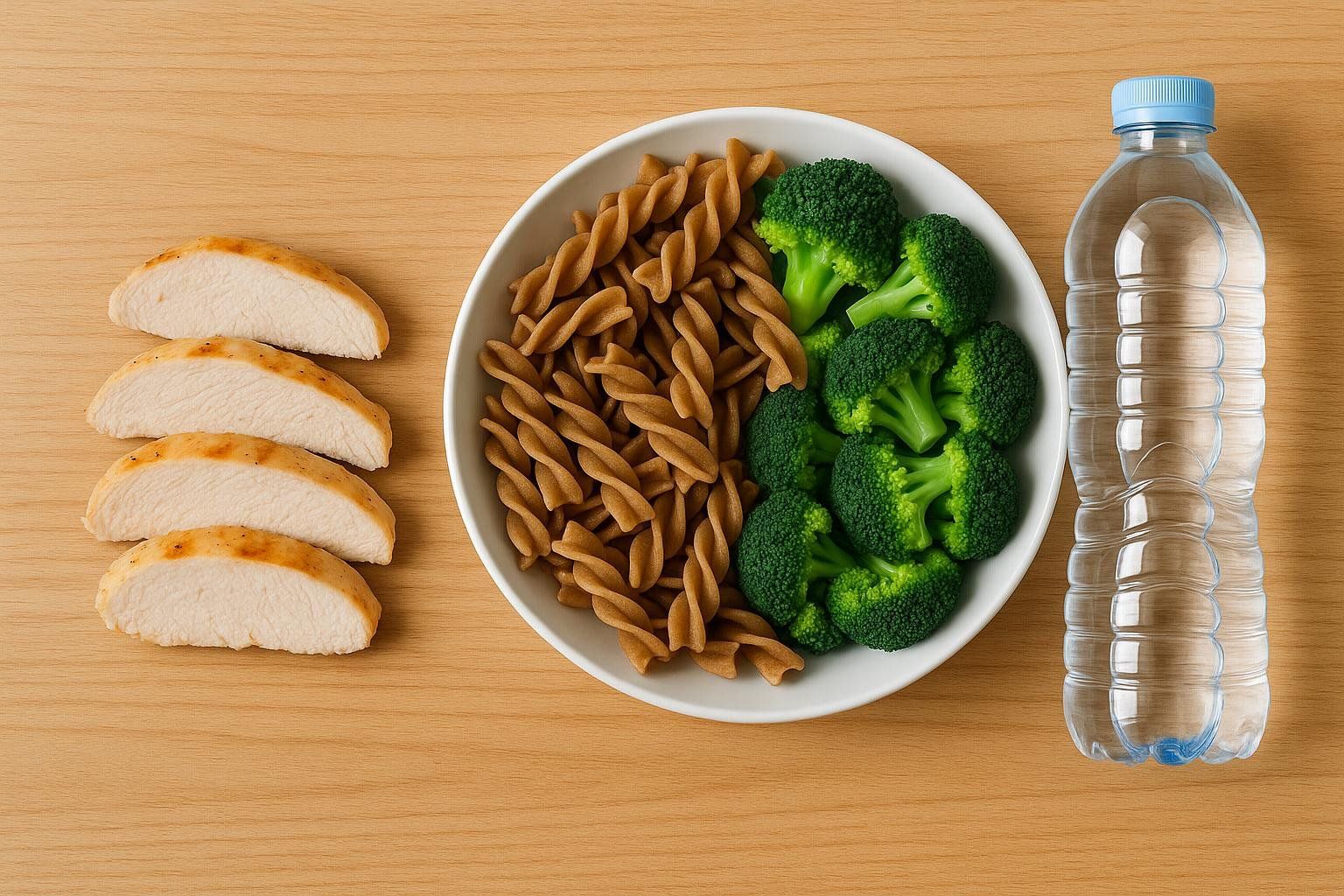
- Carbs: 5–7 g/kg/day during peak weeks, taper to 4–5 g/kg race week.
- Protein: 1.6–2.2 g/kg/day helps preserve lean mass – see the ISSN position stand on protein for athletes.
- Hydration: 5–7 ml/kg fluid with electrolytes 4 hours pre-race – per the ACSM Position Stand on Exercise & Fluid Replacement.
BodySpec DEXA scans allow for objective tracking of body composition, helping identify trends like unwanted muscle loss early so you can adjust training or nutrition before performance suffers. For fueling specifics, dive into Fueling Your Workouts: A Guide to Sports Nutrition and Hydration Strategies for Endurance Athletes.
9. Tracking Progress with BodySpec DEXA

- Baseline (Week 0): Establish lean-mass, fat-mass, and visceral-fat markers.
- Checkpoint (Week 6): Verify muscle retention during peak volume; adjust macros.
- Post-Race: Quantify adaptations, celebrate milestones, plan the next cycle.
Ready to set your baseline? Book your BodySpec DEXA scan and put real numbers behind your training.
10. Free vs Paid HYROX Plans
| Feature | This Guide’s Free Plans | HYROX PRO (HAOS) | Centr HYROX | Official HYROX App |
|---|---|---|---|---|
| Cost | $0 | $30/mo | $30/mo | $19.99/mo |
| Beginner & Advanced Tracks | ✔️ | ✔️ | ✔️ | ✔️ |
| Video Demo Library | – | ✔️ | ✔️ | ✔️ |
| Personalized Coaching | – | 1:1 (add-on) | – | Group only |
| Body-Composition Tracking | ✔️ (via DEXA scans) | – | – | – |
| Mobile Push Reminders | – | ✔️ | ✔️ | ✔️ |
Paid programs are solid, but if you value concrete body-composition metrics over generic leaderboards, pair these free plans with periodic BodySpec DEXA scans for data you can act on.
11. HYROX FAQ
How heavy are the sleds? 152 kg/335 lb push and 103 kg/227 lb pull for Men’s Pro; weights scale by category – see the HYROX Single Rulebook (PDF).
Can I train without a sled? Yes—simulate with heavy prowler pushes or low-angle treadmill walks at 15 % incline, 3 mph, holding the rails.
What’s a good first-timer goal? Sub-2 hours is realistic for most beginners with 12 weeks of structured prep.
How often should I run full simulations? Once every 4–6 weeks; more can risk overuse injuries.
Do I need a DEXA scan? Not mandatory, but it’s the gold standard for tracking lean-mass changes. Knowing exactly how much muscle you’re carrying helps dial in fueling and recovery.
Take the Next Step
Pick a plan, schedule your baseline BodySpec DEXA, and start logging split times. Twelve weeks from now, when you’re sprinting to that wall-ball target with quads of steel and lungs on fire, you’ll know the data-driven grind was worth it.
Schedule your DEXA scan today and let’s crush HYROX together.


